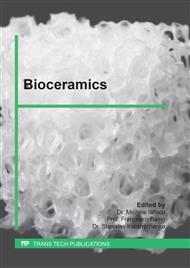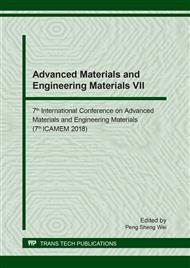[1]
M. Descamps, L. Boilet, G. Moreaua, A. Tricoteaux, J. Lud, A. Leriche, V. Lardot, and F. Cambier, Processing and properties of biphasic calcium phosphates bioceramics obtained by pressureless sintering and hot isostatic pressing, J. Eur. Ceram. Soc. 33 (2013).
DOI: 10.1016/j.jeurceramsoc.2012.12.020
Google Scholar
[2]
G.D. Webler, M.J.M. Zapata, L.C. Agra, E. Barreto, A.O.S. Silva, J.M. Hickmann, and E.J.S. Fonseca, Characterization and evaluation of cytotoxicity of biphasic calcium phosphate synthesized by a solid state reaction route, Curr. Appl. Phys. 14 (2014).
DOI: 10.1016/j.cap.2014.03.026
Google Scholar
[3]
Hench LL, and Polak JM., Third-generation biomedical materials Science 295 (2002) 1014–1017.
DOI: 10.1126/science.1067404
Google Scholar
[4]
JC. Elliot, Structure and chemistry of the apatites and the other calcium orthophosphates. Amsterdam, Elsevier Science, (1994).
Google Scholar
[5]
M. Wang, Bioactive materials and processing, in: Biomaterials and tissue engineering. Berlin, Heidelberg: Springer Verlag, (2004) p.1–82.
Google Scholar
[6]
M. Jarcho, Calcium phosphate ceramics as hard tissue prosthetics. Clin. Orthop. Rel. Res. 157 (1981) 259–78.
Google Scholar
[7]
D.S. Metsger, M.R. Rieger, and D.W. Foreman, Mechanical properties of sintered hydroxyapatite and tricalcium phosphate ceramic, J. Mater. Sci. Mater. Med. 10 (1999) 9-17.
Google Scholar
[8]
A. Balamurugan, S. Kannan, S. Rajeswari, Bioactive sol–gel hydroxyapatite surface for biomedical application-in vitro study, Trends Biomater. Artif. Organs 16 (2002) 18–21.
Google Scholar
[9]
Z. Z. Zyman, M. V. Tkachenko, and D. V. Polevodin, Preparation and characterization of biphasic calcium phosphate ceramics of desired composition, J Mater Sci: Mater Med 19 (2008) 2819–2825.
DOI: 10.1007/s10856-008-3402-9
Google Scholar
[10]
H.S. Ryua, H.J. Youna, K. S. Honga, B.S. Changb, C. K. Leeb, and S.S. Chung, An improvement in sintering property of b-tricalcium phosphate by addition of calcium pyrophosphate, Biomaterials 23 (2002) 909–914.
DOI: 10.1016/s0142-9612(01)00201-0
Google Scholar
[11]
M. Descamps, L. Boilet, G. Moreau, A. Tricoteaux, J. Lu, A. Leriche, V. Lardot, and F. Cambier, Processing and properties of biphasic calcium phosphates bioceramics obtained by pressureless sintering and hot isostatic pressing, J. Eur. Ceram. Soc. 33 (2013).
DOI: 10.1016/j.jeurceramsoc.2012.12.020
Google Scholar
[12]
S.Best, W. Bonfield, Processing behavior of hydroxyapatite powder with contrasting morphology, J. Mater. Sci. Mater. Med. 5 (1994) 516-521.
DOI: 10.1007/bf00124883
Google Scholar
[13]
S.V. Dorozhkin, Bioceramic of calcium orthophosphates, Biomaterials 31 (2010) 1465-1485.
Google Scholar



